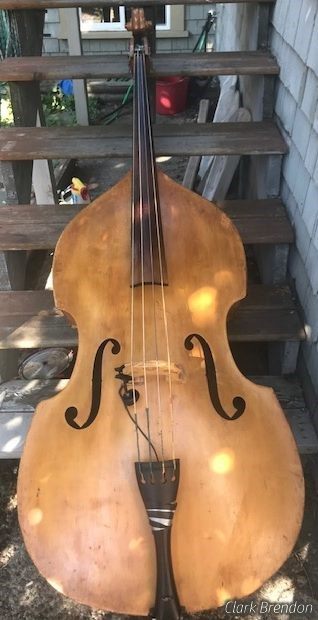KAY (and Engelhardt) BASSES: Models Over the Years...
This is a list of model numbers offered by Kay (and Engelhardt) over the years. Bob owned a blonde TV-21 once, and Kay did some odd things over their history.
This page was newly updated in July, 2022, with newly provided information from Steven Ayres of the Kay Bass and Cello Registry (kaybass.com) - with help from Kyle Perkins.
In 1937 Kay established a five-tier product system for its basses and cellos, and Engelhardt-Link continued Kay's ‘69 model designations with some spec changes through 2019, adding "E" to the part number to indicate its status as an Engelhardt.
Series ranked by price, low to high. Note that Kay specifications sometimes change or vary from standard. Engelhardt finish treatments also varied over the years without changes in model designation.
Student Series
- 89: Utility model sold under various brands, including Selmer USA, Gretsch and Silvertone. Gamba, unique asymmetrical lacquer pattern on maple top veneer, ebonized maple fingerboard, standard pinstriping, black tuning plates; usually carries no ID label; 1937-'43
- 4506: Built for Selmer USA as the Manhattan, same specs as 89; '39-40, rare
- O: Gamba, X pattern with faux graining, spruce top, ebonized maple or rosewood fingerboard, pinstriped, hatpegs or nickel tuning plates; frequently sold OEM, '37-42
- O-1: Same as O with burst contrast pattern; '48 only
- O-100: Same as O with rosewood fingerboard and rear center stripe; blonde option; '37-43
- O-127: Built for Selmer USA under Selmer-Kay label; gamba, X pattern, select spruce, rosewood fingerboard, edge purfling, bound f-holes, carved scroll, fancy hardware; blonde option; '40-41, very rare
- S-100: Slimline 6-inch ribs, gamba, X pattern, spruce top, rosewood fingerboard, pinstriping, nickel tuning plates, blonde option; '38-43, rare
Concert Series
- C, C-1: Most popular model; gamba, X pattern, spruce or maple top, rosewood or maple fingerboard, pinstriping, black tuning plates; very early labeled only Concert, with rare blonde option; '37-69. Continued as EC1 and, later, EC1B (blonde).
- C-4: Gamba, select spruce, blonde, carved scroll, rosewood fingerboard, often edge purfling, nickel tuning plates; '37-39, rare.
- CM: Concert Master; gamba, select spruce, X pattern, 3-piece neck, carved scroll, edge purfling, rosewood or ebony fingerboard, brass Czech tuning plates; '37 only, quite rare.
- In 2007 Englehardt added EG1 (red) and EG9 (blonde) as ebony-equipped gambas.
Maestro Series
- M, M-1: Maestro; Secondmost-popular model; violin corners, spruce top, + or ^ pattern, rosewood fingerboard, brass tuning plates, pinstriping; '37-69. Continued as EM1.
- M-1B: Thirdmost popular model; same as M-1 but blonde; '39-68.
- M-1AH: Original flagship model named for company designer Alvin Hawes; viol, select woods, various patterns, ebony or rosewood fingerboard, 3-piece neck, carved scroll, edge purfling, fa
 ncy tuning plates; '37-38, rare
ncy tuning plates; '37-38, rare - M-1W: Same as M-1 but often with lower-grade woods for discount price; '37-51
- M-2: Military model; Same as M-1 often with edge purfling; 37-39, rare
- H-10/M-3: Maestro Junior; Same as M-1 at 1/4-scale, black tuning plates; H-10 '47-55, M-3 '56-69. Continued as EM3.
- M-4: Same as M-1AH, but blonde; '37-38, rare
- M-5: Same as M-1 but 5-string setup, widened fingerboard, side markers at every position, blonde option; '45-54, rare
- M-6: Selmer-Kay, same as M-1AH plus f-hole binding, heel cap, custom fancy tuning plates; '37 only, quite rare
- M-7: Same as M-1 with select blonde top and sunburst back and ribs; '37 only, quite rare
- TV-1, TV-21: Painted finishes for early TV lighting; same as M-1 but with heavy matte gold (TV-1) or cream V over copper base (TV-21) paint finish, no edge stripes; '53 only, very rare
- B-5: Jazz Cello, tuned in fourths as bass; widened ebony fingerboard, pinstriping, black bass-style tuners standard; '65-67, very rare
Supreme Series
- S-1: Supreme; Violin corners, select woods, dark ^ pattern, ebony fingerboard, carved scroll, edge and f-hole purfling, heel cap, nickel tuning plates; '54-69. Continued as ES1 with spec changes.
- S-8: Swing Master; violin corners, select woods, ^ or + pattern, ebony fingerboard, carved scroll, edge and f-hole purfling, heel cap, nickel tuning plates; '39-54
- S-9: Swing Master; same as S-8 but blonde; '39-68. Continued as ES9 with spec changes.
- S-51: Same as S-8 with five-string setup, widened fingerboard, blonde option; '39-61 aka "Chubby Jackson model," bound top, back, and f-holes, ebony fingerboard and tailpiece, side position dots, shaded finish
- S-10: Same as S-9 at 1/4 scale; '48-54, very rare
- S-3: Same as S-1 at 1/4 scale; '55-67, very rare
- S-5/S-6: Original Swing Master; violin corners, select woods, Slimline 6-inch ribs, blonde (S-5) or violin finish (S-6), ebony fingerboard, heel cap, 3-piece neck, carved scroll, edge purfling, f-hole binding, fancy custom tuning plates; '37-38, very rare
- S-7: Same as S-5 with full-depth ribs; '37-38, very rare
- S-10SK: for Selmer-Kay; same as S-5 with custom fancy tuning plates; '37 only, very rare
- Additional Engelhardt-specific information:
- Concert (EC-1) models had gamba corners, Maestro (EM-1) models had violin corners. Once "ebonized" and rosewood fingerboards were discontinued in favor of Jatoba for both, this became the key distinguishing factor between the two models.
- EG-1 models were gamba versions of the ES-1; likewise, EG-9 models were the gamba version of the Swingmaster ES-9.
